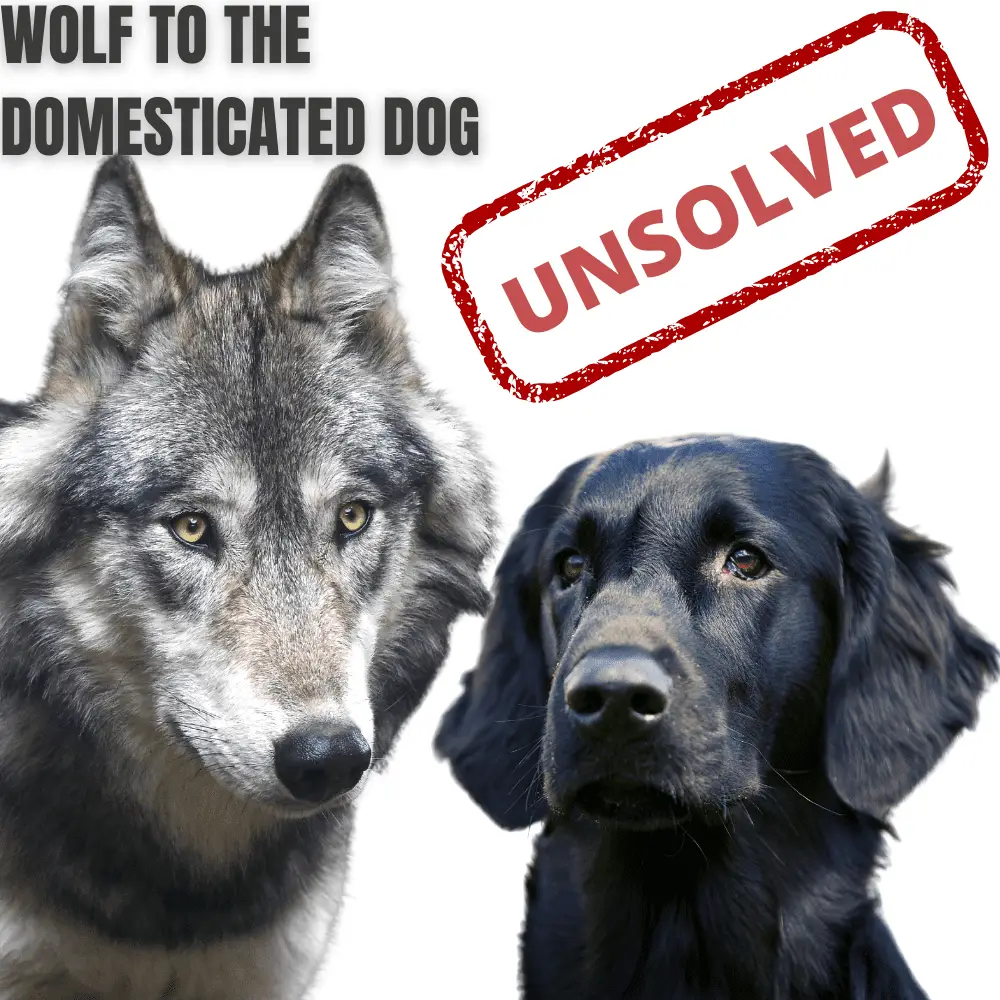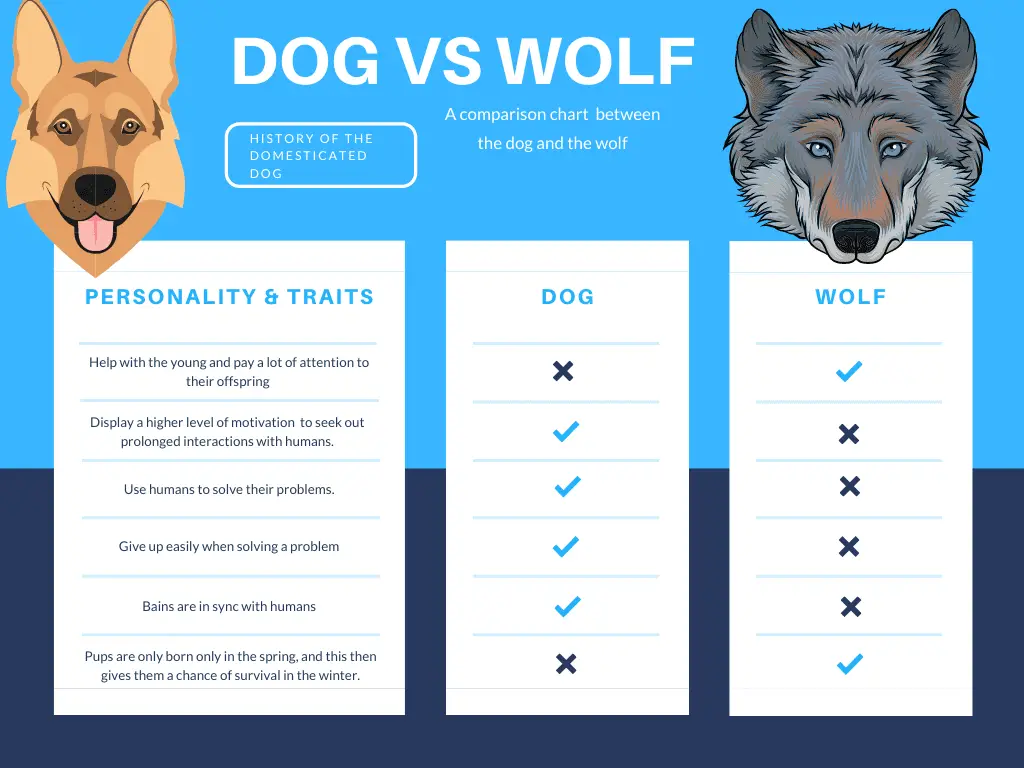We love our dogs and have various breeds to love and choose from, but have you ever wondered where dogs come from and how they were domesticated? I have spent many hours researching this subject and digesting it into something relatively easy to read and understand for all ages.
We know that the domesticated dog originated exclusively from the Wolf (Canis lupus), also known as the Grey Wolf.
How did wolves become dogs?
Experts can’t agree on how wolves first became dogs; however, there are two strong possibilities for domestication. One, human help, and two dogs themselves evolved to live with humans.
Theories Of Domestication
Human Help
Thousands of years ago, humans took Wolf puppies in and raised them as their own, whether for work, like looking after the flock, herding animals or guarding the campsites, maybe even for some company. Who knows what the thought process was behind raising them as their own? However, it’s more likely to make human life easier in some way or another. Whatever their intentions were, the Grey Wolf species became tamer and tamer with each generation born, resulting in permanent companions in the domesticated dog.
Dogs Themselves Evolved
Wolves invented themselves to become human companions. Their appearance changed, skulls shorter, teeth shrank, and their ears flopped. They gained a docile disposition to accept control or instruction and be submissive. This made the wolf less frightened and less fearful of humans. The pattern of this process is known as self-domestication. Wolves loitered around human homes, scavenged for food, and eventually understood that humans could provide them with food and shelter. They could read the expressions of humans and understand our moods, resulting in the domesticated dog and an extensive long line of different dog breeds to come.

What does self-domestication mean?
Self-domestication in dogs meant that their appearance changed to a much friendlier look over time. Self-domestication is a solid case for Theory 2 in that it’s more likely we did not domesticate dogs and that they domesticated themselves. Most social animals gained an advantage and adopted curly tails, floppy ears, and splotchy coats. Self-domestication is a proven study in many other animal species, like the fox. They have, over time, become increasingly friendlier, looking like dogs. And no doubt if they came and were raised in our homes and cared for by humans, they too will become increasingly familiar looking to humans. They already have beautiful fluffy tails, so who knows what could happen in the future with humans and foxes?
Human help taming a Wolf theory discrepancies
Wolves are hard to tame, even as puppies, and many researchers find it much more plausible that dogs, in effect, invented themselves.
Perhaps today’s dog’s affection is instincts that evolved. Because looking cute and cuddly wins us, humans, over. This way, they get what they want—plus, being a more comfortable option than loitering or scavenging.
Why did dogs evolve from wolves?
Developing is vital in all walks of life on earth. Plants, animals, and even humans evolve. Sometimes they don’t have a choice. Possibilities, why evolution takes place could be to further or secure their survival.
How long ago did this happen?
Inconclusive – Many suggested dates, and scientists cannot agree on the exact timing. However, the earliest timing recorded is forty thousand years ago.
There are two theories on how, why, when and where they evolved. The confusion and the lack of knowledge are still present to this day. The studies of where the dog’s come from are often quickly contradicted by other leading studies by scientists and archaeologists. At least it is agreed that dogs evolved from Grey Wolves.
What’s the difference between dogs and wolves today

What part of the world did dogs evolve first?
Some claim it happened in Europe, the Middle East or East Asia. We know that The Wolf (Canis lupus), the Gray Wolf or Grey Wolf’s native home, is in Eurasia in North America.
Why don’t we know exactly where the dog came from first?
The possibility of the dog being domesticated twice and in two different areas. China and another in Eurasia. Eurasia dogs migrated into Europe and China, and their dogs migrated to Europe. Interbreeding began, which created a long line of complicated explosive DNA, making it nearly impossible for experts to determine where and how the dog was first domesticated.
Dog’s and human brains are in sync.
This is fascinating! Have you ever heard of oxytocin? Well, it’s a hormone linked to love, and bonding like a mother loves a child. The strong relationship between a dog and a human is so powerful that even our brains are in sync. Dogs and humans are the first-ever known different types of species in which this occurs.
What is Oxytocin?
Oxytocin is a hormone that is released into the brain. It plays a vital role in social bonding, sexual reproduction and childbirth. Looking at your dog can cause a significant spike in oxytocin levels.
Conclusion
The two theories above both have a solid conviction. Even though the answers aren’t complete, we know where dogs come from, but the tricky question is how they were domesticated. The main problem solving the mystery is when the domestic dog has been around. We know that it happened roughly forty thousand years ago. Also, the amount of dog interbreeding has dated back thousands of years. It makes it extremely difficult for the experts to pinpoint how, why, when and where. It is a fascinating subject and a lot to debate in the coming years.
